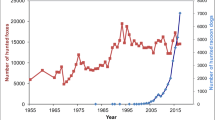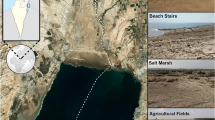Abstract
In a number of countries around the world, introduced American mink are acknowledged to have had a negative effect on a number of native species, many of which are of particular conservation concern. In the UK, there has been an observed correlation between the spread of mink and the decline of the, once common and widespread, water vole. Large wetlands, such as extensive reed bed, appear to mitigate the impact of mink predation on water voles and some bird species. The present study was carried out to test the hypothesis that the observed refuge effect of reed beds arises from the way mink forage in this type of wetland. The results suggest that the interior of reed bed offers a spatial refuge for water voles, and other species, from predation by mink, because more than 60% of mink foraging activity occurred within 10 m of a main (>10 m wide) channel. Where mink ventured within the reed bed itself, they associated closely with scrub. The implication is that easily navigable channels and areas of scrub probably compromise the refuge effect of reed beds. This can be used to inform management recommendations at these sites.

Similar content being viewed by others
References
Arnold TW, Fritzell EK (1990) Habitat use by male mink in relation to wetland characteristics and avian prey abundances. Can J Zool 68:2205–2208
Baldi A, Batary P (2005) Nest predation in European reedbeds: different losses in edges but similar losses in interiors. Folia Zoolog 54:285–292
Barreto GR, Macdonald DW (1998) The tightrope hypothesis: an explanation for plummeting water vole numbers in the Thames catchment. In: Bailey RG, Jose PV, Sherwood BR (eds) United Kingdom floodplains. Westbury, London, pp 311–327
Barreto GR, Rushton S, Strachan R, Macdonald DW (1998) The role of habitat and mink predation in determining the status and distribution of water voles in England. Anim Conserv 1:129–137
Birks JDS, Linn IJ (1982) Studies on the home range of feral mink (Mustela vison). Symp Zool Soc Lond 49:231–257
Bonesi L, Dunstone N, O'Connell M (2000) Winter selection of habitats within intertidal foraging areas by mink (Mustela vison). J Zool 250:419–424
Brown JH, Lasiewski RC (1972) Metabolism of weasels: the cost of being long and thin. Ecology 53:939–943
Carter SP, Bright PW (2003) Reedbeds as refuges for water voles (Arvicola terrestris) from predation by introduced mink (Mustela vison). Biol Conserv 111:371–376
Conner LM, Smith MD, Burger LW (2003) A comparison of distance-based and classification-based analyses of habitat use. Ecology 84:526–531
Dunstone N (1993) The mink. T. and A.D. Poyser, London
Elder WH (1951) The baculum as an age criterion in mink. J Mammal 32:43–50
Erlinge S (1977) Spacing strategy in stoat Mustela erminea. Oikos 28:32–42
Gerell R (1970) Home ranges and movements of mink Mustela vison Schreber in Southern Sweden. Oikos 21:160–173
Halliwell EC, Macdonald DW (1996) American mink Mustela vison in the upper Thames catchment: relationship with selected prey species and den availability. Biol Conserv 76:51–56
Ireland MC (1990) The behaviour and ecology of the American mink (Mustela vison Schreber) in a coastal habitat. Durham University, Durham
Jefferies DJ (1989) The changing otter population of Britain 1700–1989. Biol J Linn Soc 38:61–69
Jefferies DJ (2003) The water vole and mink survey of Britain 1996–1998 with a history of the long term changes in the status of both species and their causes. The Vincent Wildlife Trust, Ledbury, p 234
Kenward RE (2001) A manual for wildlife radio tagging. Academic, London
Kristiansen JN (1998) Egg predation in reedbed nesting Greylag geese Anser anser in Vejlerne, Denmark. Ardea 86:137–145
Lariviere S, Messier F (2000) Habitat selection and use of edges by striped skunks in the Canadian prairies. Can J Zool/Revue Canadienne De Zoologie 78:366–372
Lawton JH, Woodroffe GL (1991) Habitat and the distribution of water voles—why are there gaps in a species range? J Anim Ecol 60:79–91
Lode T (1991) Movements of the American mink Mustela vision Schreber radiotracked on a river in Britain. Mammalia 55:643–646
Macdonald DW, Harrington LA (2003) The American mink: the triumph and tragedy of adaptation out of context. N Z J Zool 30:421–441
MacPherson JL, Bright PW (2010) A preliminary investigation into whether grazing marsh is an effective refuge for water voles from predation. Lutra (in press)
McCullagh P, Nelder JA (1983) Generalized linear models. Chapman & Hall, London
Niemimaa J (1995) Activity patterns and home ranges of the American mink Mustela vison in the Finnish outer archipelago. Ann Zool Fenn 32:117–121
Previtali A, Cassini MH, Macdonald DW (1998) Habitat use and diet of the American mink (Mustela vison) in Argentinian Patagonia. J Zool 246:482–486
Salvatori V, Skidmore AK, Corsi F, van der Meer F (1999) Estimating temporal independence of radio-telemetry data on animal activity. J Theor Biol 198:567–574
Sargeant AB, Swanson GA, Doty HA (1973) Selective predation by mink, Mustela vison on waterfowl. Am Midl Nat 89:208–214
Schladweiler JL, Storm GL (1969) Den use by mink. J Wildl Manage 33:1025–1026
Schmidt KA (2004) Incidental predation, enemy-free space and the coexistence of incidental prey. Oikos 106:335–343
Sidorovich VE, MacDonald DW, Pikulik MM, Kruuk H (2001) Individual feeding specialization in the European mink, Mustela lutreola and the American mink, M. vison in north-eastern Belarus. Folia Zoolog 50:27–42
Stevens RT, Ashwood TL, Sleeman JM (1997) Fall early winter home ranges, movements, and den use of male mink, Mustela vison, in eastern Tennessee. Can Field-Nat 111:312–314
Strachan R, Jefferies DJ (1993) The Water vole Arvicola terrestris in Britain 1989–1990: its distribution and changing status. The Vincent Wildlife Trust, London
White GC, Garrott RA (1990) Analysis of wildlife radiotracking data. Academic, New York
Yamaguchi N, Rushton S, Macdonald DW (2003) Habitat preferences of feral American mink in the Upper Thames. J Mammal 84:1356–1373
Yamaguchi N, Sarno RJ, Johnson WE, O'Brien SJ, MacDonald DW (2004) Multiple paternity and reproductive tactics of free-ranging American minks, Mustela vison. J Mammal 85:432–439
Zabala J, Zuberogoitia I, Garin I, Aihartza J (2003) Landscape features in the habitat selection of European mink (Mustela lutreola) in south-western Europe. J Zool 260:415–421
Zabala J, Zuberogoitia I, Martinez-Climent JA (2007a) Spacing pattern, intersexual competition and niche segregation in American mink. Ann Zool Fenn 44:249–258
Zabala J, Zuberogoitia I, Martinez-Climent JA (2007b) Winter habitat preferences of feral American mink Mustela vison in Biscay, Northern Iberian Peninsula. Acta Theriol 52:27–36
Acknowledgements
This study was funded by the People’s Trust for Endangered Species, English Nature, the Environment Agency and the Countryside Council for Wales to whom we are very grateful. We would also like to express our thanks to Don MacPherson for help with fieldwork and to Melvyn Yeandle and Sally Mills.
Author information
Authors and Affiliations
Corresponding author
Additional information
Communicated by C. Gortázar
Rights and permissions
About this article
Cite this article
Macpherson, J.L., Bright, P.W. Movements of radio-tracked American mink (Neovison vison) in extensive wetland in the UK, and the implications for threatened prey species such as the water vole (Arvicola amphibius). Eur J Wildl Res 56, 855–859 (2010). https://doi.org/10.1007/s10344-010-0383-z
Received:
Revised:
Accepted:
Published:
Issue Date:
DOI: https://doi.org/10.1007/s10344-010-0383-z




